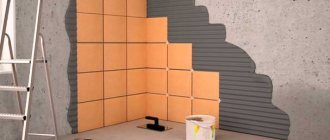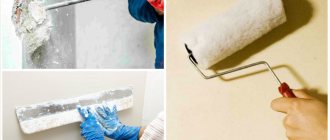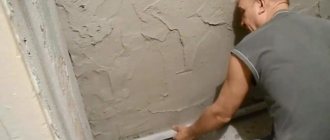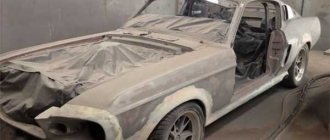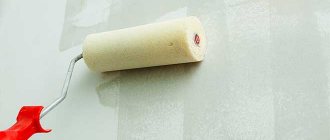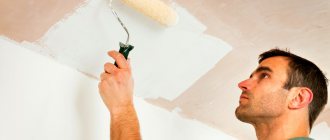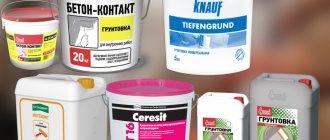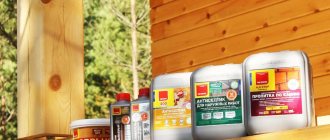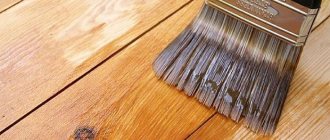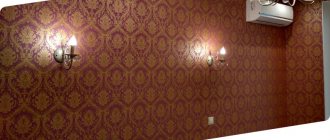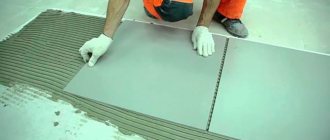Tiles are laid on different surfaces; this is a popular type of material that is distinguished by the variety of colors offered. The finish can last a long time, but the condition for such durability is the correct installation of the tiles. To increase bond strength and improve the quality of the repair, you should use a tile primer. At the same time, special attention should be paid to the choice in order to purchase the best option suitable for specific working conditions. The best way to prime the walls in the bathroom under tiles and in other rooms will be discussed below.
Why is a primer needed?
A primer is necessary before laying tiles primarily in order to increase the stability of the tiles, which increases their service life.
There are a large number of varieties of the mixture, some of which additionally protect the material from corrosion, in case the tiles are laid on metal.
Also, the primer may have antiseptic properties, so there is no doubt about the need to prime the surface before laying the tiles.
Beneficial features
Loose surfaces that absorb moisture well should be treated several times. Should
you prime the floor before laying the tiles or not? This is a question asked by many people who encounter this for the first time.
If you ask advice from specialists, you can get the answer that the action is considered mandatory when performing almost any repair or finishing work.
On loose or porous surfaces, several coats can be applied. Using a primer on a concrete base followed by laying tiles leads to the following results:
- Strengthens the surface and binds it. The liquid penetrates deep into the pores, strengthens the structure, thereby making it more resistant to dynamic and static loads.
The primer will protect the adhesive layer from delamination - After the base is treated with a primer, the tile adhesive adheres better to the surface.
- With its help, you can ideally prepare the surface for laying tiles. The primer coating effectively covers all remaining dust particles.
- If you do not pre-treat the surface, the tile adhesive will dry out too quickly, as moisture from the bottom layer will be absorbed into the surface. The result will be delamination of the layer and gradual peeling of the tile.
You can evaluate the impregnation almost immediately after laying the tiles. The floor will not leak and have unpleasant odors typical of mold.
How to make the right choice
As mentioned above, today there are a large number of soil mixtures, each of them has a unique composition and is used in certain cases.
To make the right choice among the variety of options, you need to follow several rules.
- First of all, you need to pay attention to the packaging. Cheap types of primers will require re-application, i.e. before laying the tiles you need to apply the primer in 2 layers. As a rule, this technology is not very reliable and is typical only for cheap types of soil. It is recommended to overpay a little and purchase a high-quality mixture that only needs to be applied once.
- It is necessary to take into account the characteristics of the material on which the primer is supposed to be applied. The recommended compositions for wood, metal and concrete are significantly different, you need to take this into account when choosing the appropriate option.
Expert advice
If you are going to cover a plasterboard surface, it must be handled very carefully to avoid deformation. To begin with, it must be thoroughly puttied. Drywall should be taken from the GVLV brand.
Experts do not recommend covering porous surfaces such as plywood, but if there is no way out, then you need to use a special strengthening liquid concentrate for materials of such absorbent capacity.
To increase adhesion between the base and marble or porcelain stoneware products, treatment with solutions is used to roughen the surface.
You must work with the composition carefully, because it is not so easy to remove from the ceramic surface. If this happens, you can try to remove the solution with soapy water. If it doesn’t work, you can soak the stain for several hours, covering it with damp rags. In difficult cases, you can use a glass cleaner.
What and how to prime (2 videos)
Types of primer
Let's look at the main types of soil mixtures available for sale.
Acrylic
Today this is the most popular type of primer. This is due to the fact that its composition is universal and can be used to create a suitable soil mixture for virtually any material.
In addition, the cost of such a primer is relatively low, which makes it affordable and also very reliable.
Alkyd
A variety of primers based on this component element are as durable as possible. The compositions are ideal for application to glass, metal and tiles. For other materials, this variety is not the best option when choosing.
Based on cement and gypsum
Such compositions also have lime as one of the main components. Perfect for concrete or brick surfaces covered with a layer of plaster.
This is much more convenient than preparing plasterboard for laying tiles.
- These are just the main directions intended for certain materials.
- There are also subspecies based on them, which have deep penetration into materials, providing maximum adhesion to the tiles, also with antiseptic properties; they must be selected as carefully as possible.
The process of preparing the mixture
To obtain the best performance, primer for concrete under tiles should be prepared strictly according to the manufacturer’s recipe. If you need to deeply saturate the surface with a primer solution, you can apply it in two layers. In this case, the second layer will be applied before the first one dries.
Then two compositions of different concentrations are prepared, for the starting layer the ratio is 1 to 16, for the finishing layer 1 to 12. But there is no need to apply a second layer of primer solution to the dried floor covering or walls; then you won’t be able to get the desired effect.
If you need to deeply saturate the surface with a primer solution, you can apply it in two layers.
Primer for materials
When working with each material, you need to take into account its characteristics.
- So, for example, if it is necessary to prime drywall, you must first thoroughly putty it.
- Please note that it is recommended to select waterproof materials so as not to deform the drywall.
- Only after this can a primer be applied that is suitable in composition for this material.
If you need to lay tiles on plywood, you must first carefully prepare it. This is due to the fact that it has a porous surface, so you need to first apply an adhesive mixture, which will allow you to properly apply the primer and tiles on it.
When working with marble and other similar materials, you should give preference not to strengthening compounds, but to primers containing sand. They will allow you to achieve greater adhesion to the tiles, which will have a positive effect on the reliability of the fastening.
Internal and external corners
What to do if you need to design internal and external corners?
When choosing tiles, pay attention to the corner elements that are now present in catalogs and perfectly solve the problem of fitting, or get ready for painstaking work:
- place two tiles perpendicular to each other and make a joint between the tiles,
- cut the end at an angle of 45° and join - the most labor-intensive work, only an experienced craftsman can do it,
- use a special profile to cover the corner joint.
How to remove unnecessary things
If the primer accidentally gets on the front surface of the tile, there are several ways to correct the situation.
- First of all, you need to try regular warm water with soap and a sponge or rag.
- This method is only suitable if the primer has just been applied to the surface and has not yet had time to harden.
- It is worth considering that the composition hardens quite quickly, so you cannot hesitate.
If the composition has already dried, you can try to cover the stain with damp rags, this will soften the primer on the front side of the tile, and then carefully remove it with a rag and soapy warm water.
If the primer stain is already old, you cannot do without using special cleaning products for plumbing fixtures. Preference should be given to potent compounds, but without abrasive additives, because they can scratch the tiles. It is also recommended to try glass cleaners in the fight against stains of dried primer, they help a lot.
Conclusion
Choosing a primer is not as difficult as it seems at first glance; you need to decide on the type of base, after which you will know exactly what you need to purchase. The video in this article will help you understand the issue even better, and if you don’t understand anything, feel free to write in the comments under the review.
Did you like the article? Subscribe to our Yandex.Zen channel
August 26, 2016
Bathroom, Construction Chemicals, Construction and Repair
If you want to express gratitude, add a clarification or objection, or ask the author something, add a comment or say thank you!
Primer Application Instructions
In order to apply the primer correctly, you must strictly follow the rules and recommendations provided by the manufacturers.
- It is also necessary to carefully prepare the material in advance; if it is metal or glass, it must first be degreased and cleaned of all contaminants.
- This will increase the adhesion between the material and the primer, which will also have a positive effect on the reliability of the laid tiles.
- It is also necessary to take into account the entire tile and the characteristics of the material on which it is laid. This should be taken into account in particular when covering walls indoors.
Tiles that are too heavy may simply fall off the wall if the physical characteristics of the materials are not taken into account and the adhesive composition is not selected correctly.
Features of surface preparation
The requirements for the surface before priming are simple:
- Remove old finishes (paint, wallpaper), oil and grease stains. To do this, use any means and tools.
- Seal defects larger than 1 cm with repair solutions.
- Clean from dirt and dust.
Attention! If the wall has a large difference in plane (more than 2 cm), then you need to get rid of it. For this purpose, plasters or putties are used.
